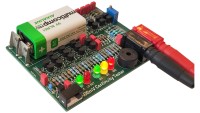100mV Continuity Tester

A new take on the classic continuity tester in several ways. This tests with just 100mV across the probes, so it ignores semiconductor junctions and its low input impedance makes it immune to even very large capacitances. It displays continuity to 3 thresholds and generates 3 different tones. All transistor based (instead of 5 op-amps!). Easy to build all-in-one design.
· Test continuity in or out of circuit instantly.
· Only 100mV test voltage across an open circuit.
· 3 low resistance thresholds: 2Ω, 5Ω and 10Ω.
· 3 tones of audible alert.
· Low battery warning.
· Not affected by semiconductor junctions.
· Highly immune to even very large capacitances.
· Fast response (faster than many multimeters).
· Nearly all transistor based (except the regulator).
· Standard 4mm sockets.
Introduction
This design started as a “self challenge”. I wanted to design a good quality continuity tester that would not be fooled by semiconductors and large capacitances. I also wanted to make it with no ICs. Crazy? Yes, of course. The design would be much simpler with a couple of cheap quad Op-Amps, or even a little micro, but where’s the fun in that?
Apart from the voltage regulator (which is a low dropout 5V regulator in a TO92 package), there are no ICs at all in this design.
The design is based around long-tailed-pairs (LTPs). LTPs are most frequently seen at the core of Op-Amps.
One LTP is used as a linear amplifier, to amplify the small voltage across the test probes.
Further LTPs are used as comparators to detect the various thresholds associated with 2Ω, 5Ω and 10Ω being across the test probes.
A final LTP is used for low battery monitoring.
Design Overview
The design comprises of the following stages:
Input Front End - To create 100mV across the probes.
Linear Amplifier - To amplify the voltage across the probes.
Comparators - To switch on LEDs when the amplified voltage reaches certain thresholds.
Oscillator - To produce an audible tone which varies according to the number of LEDs lit.
Comparator - For low battery detection.
The design comprises of the following stages:
Input Front End - To create 100mV across the probes.
Linear Amplifier - To amplify the voltage across the probes.
Comparators - To switch on LEDs when the amplified voltage reaches certain thresholds.
Oscillator - To produce an audible tone which varies according to the number of LEDs lit.
Comparator - For low battery detection.





Discussie (13 opmerking(en))
wwjd1924 2 maanden geleden
Jeremy Siddons is the director of the PeakTech company so this design of him looks great.
I don't know if I am allowed to publish the PCB files here??
CerealKiller 2 maanden geleden
Thank you!
Fozzie Bear 5 maanden geleden
CerealKiller 5 maanden geleden
H Tempelman 5 maanden geleden
Philippe Angerand 5 maanden geleden
Flupke 5 maanden geleden
Best regards
P.P
Ralf Kienzle 6 maanden geleden
If would be perfect if you could provide the gerber file, too.
Best regards
Ralf
DE0074562ID 6 maanden geleden
Please provide hint how to use it.
Regards Heinz
Elekreader 6 maanden geleden
DE0217545ID 6 maanden geleden
Karsten
DE0164350ID 6 maanden geleden
Bei Bedarf kann ich das auch gerne über art-of-electronics.blog organisieren. Möchte mich aber nicht aufdrängen.
Grüße
Michael
CerealKiller 5 maanden geleden
larry washburn 6 maanden geleden
DE180825 6 maanden geleden
Viele Grüße!
Joachim
CerealKiller 6 maanden geleden
Thanks
Robert
CerealKiller 6 maanden geleden
You wouldn't have a spare PCB, by chance?
Thanks for a short notice, cheers
Robert